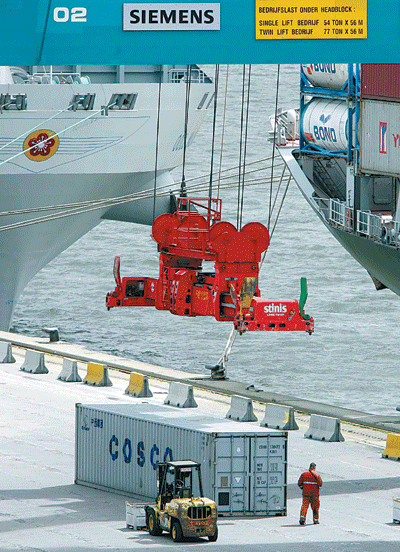Giving a hand for free trade
Updated: 2012-04-06 07:50
By Zheng Yangpeng in Antwerp, Belgium (China Daily)
|
|||||||||||
 |
|
A crane prepares to lift a shipping container at the Noordzeeterminal, a container port run by PSA Singapore Terminals in Antwerp, Belgium. The port has established relationships with several Chinese ports in Shanghai, Ningbo and Shenzhen. [Wolfgang Von Brauchitsch / Bloomberg News] |
Atop a fountain outside city hall in Antwerp, Belgium, stands a statue of man who is running while holding a severed hand.
The figure is meant to represent Silvius Brabo, a mythical Roman soldier from more than 2,000 years ago who's famous for his defeat of Antigoon, a giant said to have exacted a toll from every ship that sailed down the nearby river Scheldt.
According to legend, Brabo cut off the giant's hand and threw it in the Scheldt's waters, a deed that eventually brought trade and prosperity to the northern Belgian port city.
The tale of Brabo is not only thought to have given Antwerp its name - "handwerpen" means "hand throwing" in Flemish - but has also become a symbol of free trade. Conducting business across borders is essential to the port city, which handles the second largest amount of imports and exports of any European city, following only Rotterdam in the Netherlands.
Marc Van Peel, president of the Antwerp Port Authority, said he hopes the statue can inspire leaders to further liberalize trade between Europe and China, a change he thinks would bring more cargo to the port.
"There are still existing trade barriers and some protectionism," Van Peel said when asked about the port's relationship with China.
"I hope sincerely that in international trade, we'll overcome these obstacles."
In 2011, the port handled 27 percent more container cargo and 42 percent more total cargo from China. That was in stark contrast with the port's global business, which increased by 4.6 percent to reach 186 million tons that year. A report by the Chinese Academy of Sciences said half of those gains can be attributed to trade with China.
Antwerp has also established relationships with several Chinese ports in Shanghai, Ningbo and Shenzhen.
Van Peel said the gains would come even faster if there were fewer trade barriers.
"The free trade principle, which is embodied by the statue, can bring benefits to all parties," he said.
He said one of the port's greatest advantages lies in its location. Antwerp is in the center of what he called the "blue banana" region, which is composed of southern England, Belgium, the Netherlands, western Germany and northern Italy.
Van Peel also noted that the port is connected to a series of industrial parks and warehouses, where various shipping and storage services can be easily obtained.
Cargo unloaded in Antwerp can now reach the European heartland on inland waterways, roads or rails.
A strong labor force and an advanced information system have helped make the port more productive, Van Peel said.
"We have dock labor that by far is the most productive in Europe," he said.
Liu Guojin, Far East adviser of the Antwerp Port Authority, said the port's productivity is reflected in its container mobility frequency, a measure of how often containers can be moved in an hour. The Antwerp port's figure stands at 35, while it is less than 30 at many other ports.
During busy seasons, such as the summer, the port often must contend with a shortage of dockworkers. Many people in the industry, he explained, prefer to use that season to take their families on vacation or watch soccer matches.
zhengyangpeng@chinadaily.com.cn
Today's Top News
President Xi confident in recovery from quake
H7N9 update: 104 cases, 21 deaths
Telecom workers restore links
Coal mine blast kills 18 in Jilin
Intl scholarship puts China on the map
More bird flu patients discharged
Gold loses sheen, but still a safe bet
US 'turns blind eye to human rights'
Hot Topics
Lunar probe , China growth forecasts, Emission rules get tougher, China seen through 'colored lens', International board,
Editor's Picks

|

|

|

|

|

|





